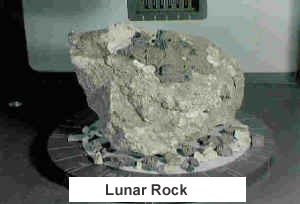BACKGROUND:
 The surface of the Moon is very different from the
Earth’s surface. There is little or no tectonic movement on the Moon like
on the Earth. The Moon’s surface has remained the same for billions of
years. The Moon lacks water and an atmosphere. The weathering, erosion, and
tectonic processes common to the Earth does not happen on the Moon.
The surface of the Moon is very different from the
Earth’s surface. There is little or no tectonic movement on the Moon like
on the Earth. The Moon’s surface has remained the same for billions of
years. The Moon lacks water and an atmosphere. The weathering, erosion, and
tectonic processes common to the Earth does not happen on the Moon.
The Moon has many surface features that we do not have
on Earth. The following features can be identified on the Moon’s surface:
MARE or "SEAS" - These are relatively
smooth, dark, and large areas that are filled with lava. The mare formed
when the craters formed by large asteroid impacts were filled by lava. Most
mare are more than 3 billion years in age. They can be easily seen on the
Moon using a telescope from Earth
MOUNTAINS AND MOUNTAIN RANGES
- The Moon’s mountains are large, rounded "bumps," which look
much like old, eroded mountain ranges on Earth. The Moon’s mountains are
even older than the mare, dating back as far as 4.4 billion years.
CRATERS - These roughly circular depression in
the surface formed when meteoroids struck the Moon at high speeds. The Moon’s
surface has hundreds of thousands of craters. The craters can be large
(hundreds of kilometers) to as small as one meter.
RAYS - Rays are bright streaks of debris that
radiate from some large craters. They may be as long as 3000 km.
RILLS - These are cracks in the surface of the
Moon, probably produced by moving of the surface similar to faulting on the
Earth.
PROCEDURE:
- Read "Dancing on the Moon" to provide students an experience on the
Moon.
- In this activity, the students will first find features on the Moon,
and then compare them with the Earth. Remind students that the Moon is
much smaller than the Earth, and revolves around the Earth, much as the
Earth/Moon system revolves around the Sun.
- Explain to the students the different features that you would like
them to locate. You should include most of the features described in the
background, depending on the resolution of the Moon maps you have for
the students to examine.
- Give the students the worksheets and have them try and locate
features. You might start by asking them to look in the same areas, and have the
student who finds a certain feature first raise his or her hand. This
will help the students look for detail. You may wish to have the
students work with a partner. You may want them to circle the areas you
ask them to locate and identify the feature.
- Ask students the following questions. These are only suggestions. You
may also want the students to compare and contrast the two sides of the
Moon.
- Locate two mare on the moon map and list them on another piece of
paper. Are mare large or small? Are there more mare on the eastern
western part of the Moon? (The many SEAS OR MARE are more prominent
on the western portion of the Moon. There are many named ones for
students to choose from. They are large.)
- Locate and name a mountain range on the Moon. (There are only 3
mountain ranges labeled on most Moon maps: the Caucasus Mts., the
Apennine Mts., and the Jura Mts.)
- Find and name three craters. Are there many or few craters on the
Moon? (CRATERS are the round depressions on the map. Many are
named.)
- Name two craters that are have rays. (RAYS are prominent on the
eastern portion of the Moon, especially radiating from the craters
Copernicus, Kepler, and Herodotus.)
- Find and name one rill. (RILLS are difficult to locate. On the
western portion, Hyginus Cleft is one. On the eastern portion, the
Straight Wall is a rill.)